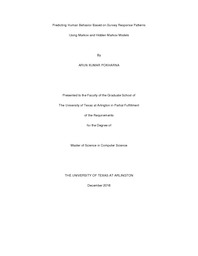
ATTENTION: The works hosted here are being migrated to a new repository that will consolidate resources, improve discoverability, and better show UTA's research impact on the global community. We will update authors as the migration progresses. Please see MavMatrix for more information.
Show simple item record
| dc.contributor.advisor | Levine, David | |
| dc.contributor.advisor | Huber, Manfred | |
| dc.creator | Pokharna, Arun Kumar | |
| dc.date.accessioned | 2017-02-14T16:38:37Z | |
| dc.date.available | 2017-02-14T16:38:37Z | |
| dc.date.created | 2016-12 | |
| dc.date.issued | 2016-12-09 | |
| dc.date.submitted | December 2016 | |
| dc.identifier.uri | http://hdl.handle.net/10106/26434 | |
| dc.description.abstract | With technological advancements in World Wide Web (www), connecting with people for gathering information has become common. Among several ways, surveys are one of the most commonly used way of collecting information from people. Given a specific objective, multiple surveys are conducted to collect various pieces of information. This collected information, in the form of survey responses, can be categorical values or a descriptive text that represents information regarding the survey question. If additional details regarding the response behavior, scenario in which survey is being responded, or survey outcomes is available, machine learning and prediction modeling can be used to predict these events from the survey data, potentially permitting automatically triggered interventions or preventive actions that can potentially prevent detrimental events or outcomes from occurring.
The proposed approach in this research predicts human behavior based on their responses to various surveys that are administered automatically using an interactive Web–Phone-Computer system. This approach is applied to a typical classroom scenario where students are asked to periodically fill out a questionnaire about their performance before and after class milestones such as exams, projects, and homework. Data collection for this experiment is performed by using Teleherence, a web-phone-computer based survey application. Data collected through Teleherence is then used to learn a predictive model. The approach developed in this research is using clustering to find similarities between different students’ responses and a prediction model for their behavior based on Markov and Hidden Markov model. | |
| dc.format.mimetype | application/pdf | |
| dc.language.iso | en_US | |
| dc.subject | K-means clustering | |
| dc.subject | Customized distance function | |
| dc.subject | Markov Model | |
| dc.subject | Hidden Markov Model | |
| dc.subject | Baum-Welch algorithm | |
| dc.subject | Simulated annealing | |
| dc.subject | Weight learning | |
| dc.subject | Human behavior prediction | |
| dc.subject | Surveys | |
| dc.subject | Teleherence | |
| dc.subject | Varying length inputs | |
| dc.title | Predicting Human Behavior Based on Survey Response Patterns Using Markov and Hidden Markov Models | |
| dc.type | Thesis | |
| dc.degree.department | Computer Science and Engineering | |
| dc.degree.name | Master of Science in Computer Science | |
| dc.date.updated | 2017-02-14T16:38:37Z | |
| thesis.degree.department | Computer Science and Engineering | |
| thesis.degree.grantor | The University of Texas at Arlington | |
| thesis.degree.level | Masters | |
| thesis.degree.name | Master of Science in Computer Science | |
| dc.type.material | text | |
| dc.creator.orcid | 0000-0003-1057-4895 | |
Files in this item
- Name:
- POKHARNA-THESIS-2016.pdf
- Size:
- 1.668Mb
- Format:
- PDF
This item appears in the following Collection(s)
Show simple item record


